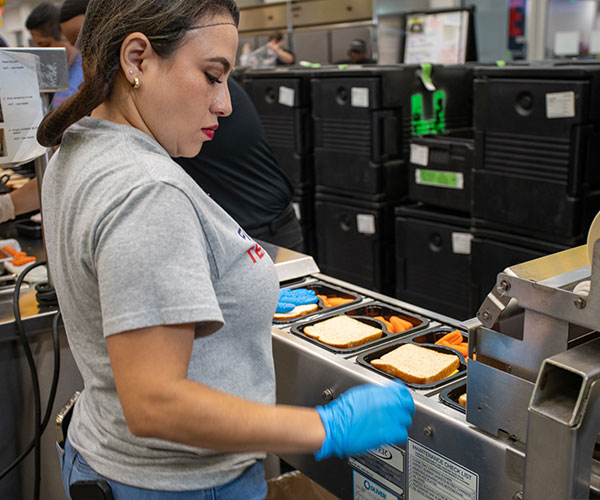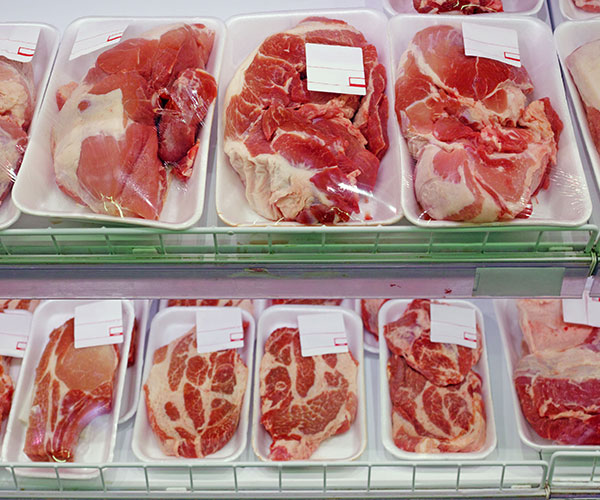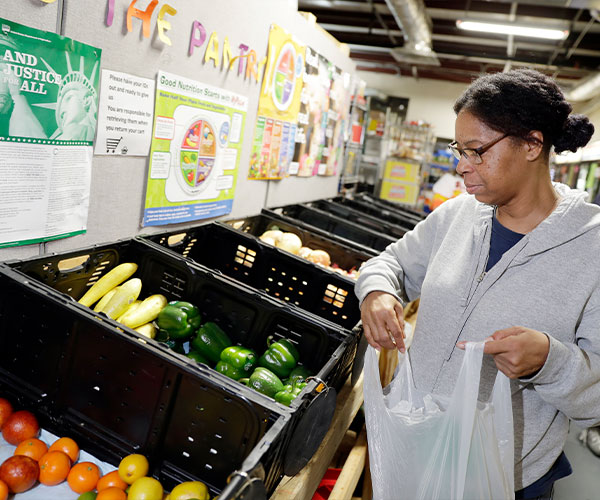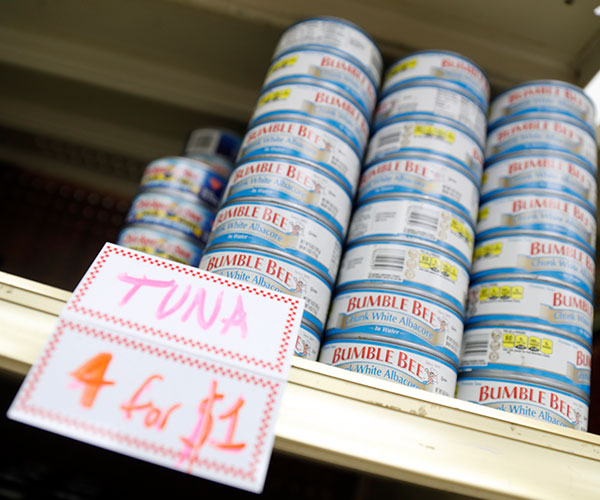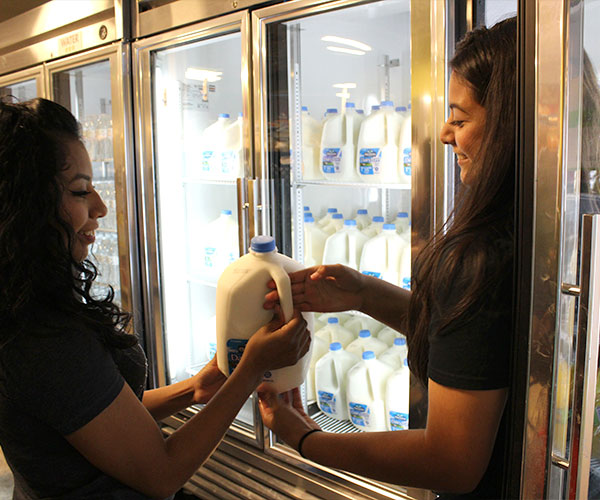Product Toss Guidelines
Did you know a lot of food can last well beyond the sell by date? Learning how long food lasts can reduce food waste and help you make more financially efficient choices when shopping for food. It can also help in times of disaster and any other time when you and your family are feeling financial strain.
Product Toss Guidelines
Did you know a lot of food can last well beyond the sell by date? Learning how long food lasts can reduce food waste and makes you more financially efficient with purchasing food. It can also help in times of disaster and whenever else you and your family are feeling financial strain.
Consumer Tips

- Wash hands as well as utensils, containers and work surfaces thoroughly with hot soapy water before and after coming into contact with raw meat, poultry, seafood or eggs.
- Keep cold foods cold (40° F or below) and hot foods hot (140° F and above).
- Use an appliance thermometer to ensure your refrigerator stays at 40° F or below; the freezer at 0° F or below.
- Use a meat thermometer for cooking, and check to see that hot food stays at 140° F or above in a chafing dish on a buffet.
- Never keep perishable foods at room temperature for any longer than two hours – including time to prepare, serve and eat.
- Never allow cooked or prepared foods to come in contact with raw meat juices. For example, never put cooked meat on the same plate used for raw meat. Use separate, clean utensils and wash your hands frequently.
- Keep a clean kitchen and avoid cross-contamination between raw meat, poultry, seafood and eggs, and fruits and vegetables that will be eaten raw.
- Never chop or slice raw produce on a cutting board that was used for raw meats, poultry or seafood without cleaning or sanitizing it first.
- Wash fresh fruits and vegetables with running water and scrub with a vegetable brush when appropriate.
- When shopping, pick up meat, poultry, seafood, dairy, and other refrigerated or frozen items last.
- Store seafood in the coldest part of the refrigerator.
- Serve cooked eggs and dishes containing eggs hot and refrigerate within two hours to serve chilled at a later time.
- Examine containers for leaks or other damage.
- Many states require dating on dairy products. The “sell by” date is the last date a product should be offered for sale so that you will have a reasonable amount of time to use the food at home. The “sell by” date is not the same as the “consume by” date.
- Go directly home from the supermarket and refrigerate the products as soon as possible.

Supermarket Deli Guidelines
Your supermarket maintains rigid quality assurance and sanitation standards to ensure that you always receive fresh, wholesome products. Once you purchase the food, it’s up to you to take care of it. This is important, especially for these perishable foods, because a large number of foodborne illnesses are caused by improper handling of foods in the home.
DELI MEATS…
Buy deli meats in quantities that can be used in three to five days. Properly wrap and freeze deli meats that can’t be used in that time. Rely on your senses — touch, sight and smell — to pick up signs of spoilage:
- Off colors such as grey or green. An iridescent sheen is normal on ham and roast beef due to the mineral content.
- Off odors.
- A sticky or tacky surface.
… AND DELI CHEESES
In general, the harder the cheese, the longer the shelf life in your refrigerator. Thus, harder cheeses such as cheddar and colby jack will have a longer life than will soft cheeses such as Brie and queso fresco.
Wrap cheese tightly. The only exception to this is the blue-vein cheeses, which need “breathing room.”
Certain types of bacteria are needed for cheeses to ripen, but they also make cheeses quite prone to mold. Don’t make the mistake, however, of throwing out hard cheese that has only surface molds. To be safe, cut off the mold and the surrounding 1/2-inch of hard cheese. Discard any moldy soft cheeses.
FROZEN AND REFRIGERATED PREPARED FOODS
These foods usually come with explicit directions on defrosting and cooking. Read and follow the package instructions.
Thoroughly cook or reheat all refrigerated prepared foods to an internal temperature of 165° F. Never set your oven under 325° F for cooking or baking meat or poultry, since oven temperatures lower than that can increase bacterial growth. Don’t purchase packages or containers whose seals, wraps or lids are broken or otherwise damaged.
HOT FOODS
Your supermarket will frequently check hot-held foods. Do not purchase lukewarm foods. Consume hot foods within two hours of purchase or refrigerate them.
Keep food containers sealed until ready to use. Reheat takeout food in a microwave or standard oven to 165° F, or until steaming hot.
- Leftovers should be refrigerated or frozen promptly. Use leftovers within three to four days.
- Cool foods immediately in shallow pans or bowls in the refrigerator to let air circulate.
DELI SALADS
- Use prepared salads like potato, macaroni and coleslaw within three to five days.
- Follow the two-hour limit in leaving prepared salads out of the refrigerator. In summertime, shorten the two-hour rule. It looks great to spread all the food out on the picnic table, but it’s safer to keep cold foods in coolers until right before eating.
- Give each salad a separate, clean spoon for serving, cover tightly when storing, and keep a watchful eye on color and texture. Although some salads get a “distressed” look because of their tendency to form a skin, the skin itself is not bad and all you have to do is mix and blend—with a clean utensil.
Meat and Poultry Guidelines
Your supermarket maintains rigid quality assurance and sanitation standards to ensure that you always receive fresh, wholesome meat and poultry products. Once you purchase the food, it’s up to you to take care of it. This is important, especially for these perishable foods, because a large number of foodborne illnesses are caused by improper handling of foods in the home.
MEAT AND POULTRY
- When shopping, pick up meat, poultry, seafood, dairy, and other refrigerated or frozen items last.
- Food product dating is not a Federal requirement. However, if a date appears on meat and poultry, observe it. Purchase perishable foods before a “sell by” date expires. Some manufacturers may post a “use-by” or “best-if-used-by” date on products. Follow that date at home.
- Do not buy packages that have been opened or damaged. Open packages or seals invite bacterial contamination.
SAFE HANDLING
- Choose ground meat packages that are cold and tightly wrapped. The meat surface exposed to air will be red; the interior of fresh meat will be dark.
- Pack perishables in an ice chest if it will take you more than an hour to get home.
- Place ground meat and ground poultry in the refrigerator or freezer immediately.
- Defrost frozen ground meats in the refrigerator — never at room temperature. If microwave defrosting, cook immediately.
SAFE STORAGE
- Set your refrigerator at 40° F or colder and your freezer at 0° F or colder.
- Keep uncooked ground meat and ground poultry in the refrigerator; cook or freeze within one to two days.
- Use or freeze cooked meat and poultry stored in the refrigerator within three or four days.
- For best quality, store frozen raw ground meats no longer than three to four months; cooked meats, two to three months.
CLEAN IT!
Keep everything clean — hands, utensils, counters, cutting boards and sinks. That way your food will stay as safe as possible.
- Always wash hands thoroughly in hot soapy water before preparing foods and after handling raw meat.
- Don’t let raw meat or poultry juices touch ready-to-eat foods either in the refrigerator or during preparation.
- Don’t put cooked foods on the same plate that held raw meat or poultry.
- Wash utensils that have touched raw meat with hot, soapy water before using them for cooked meats.
- Wash counters, cutting boards and other surfaces raw meats have touched. And don’t forget to keep the inside of your refrigerator clean.
DEFROSTING, PREPARING AND COOKING
- Defrost frozen meat and poultry in the refrigerator; under cold running water in airtight packaging; or in the microwave. Never thaw at room temperature, in the sink or on the counter. Cook microwave-thawed foods immediately. Meat and poultry thawed in the refrigerator may be refrozen. It is not necessary to rinse raw red meat or poultry before cooking.
- Always marinate meat and poultry in the refrigerator, never at room temperature.
- When grilling, use separate plates for carrying raw and cooked meat. Never put cooked meat on the same plate used for raw meat. That’s cross contamination!
- Stuffing whole poultry must be done with special care because bacteria from raw poultry can multiply in the stuffing. Stuff just before cooking, stuff loosely (no more than 2/3 full), and be sure the stuffing reaches 165° F — either inside the bird or when cooking it in a casserole.
- Use a meat thermometer to be sure meat and poultry reach a safe temperature. Beef, veal and lamb roasts, steaks and chops can be cooked to 145° F (medium rare) to 160° F (medium). All ground meats and pork should be cooked to 160° F; ground poultry, 165° F; whole poultry, 180° F; poultry breasts, 170° F.
- Cooking kills harmful bacteria. Be sure ground meat and ground poultry are cooked thoroughly. Use a thermometer to ensure proper cooking.
- Ground meat patties and loaves are safe when they reach 160° F in the center; ground poultry patties and loaves, 165° F, regardless of color.
- During broiling, grilling, or cooking on the stove, turn meats over at least once.
- When baking, set the oven no lower than 325° F.
- If microwaving, cover meats. Midway through cooking, turn patties over and rotate the dish; rotate a meat loaf; and stir ground meats once or twice. Let microwaved meats stand to complete the cooking process.
After cooking, refrigerate leftovers immediately. Separate into small portions for fast cooling.
To reheat all leftovers, cover and heat to 165° F or until hot and steaming throughout.
Fresh Produce Guidelines
The selection in your supermarket’s produce department continues to expand rapidly as fruits and vegetables become available. Your supermarket maintains rigid quality assurance and sanitation standards to ensure that you always receive fresh, wholesome produce. Once you purchase the food, it’s up to you to take care of it. This is important, especially because of the large number of foodborne illnesses caused by improper handling of foods in the home.
WHAT IS ORGANIC PRODUCE?
Some states have programs in place to certify that produce have been raised organically, that is, without the use of synthetically produced pesticides. Crop rotation, integrated pest management (using “good” bugs to destroy “bad” bugs), and enriching the soil with grass or other natural fertilizers are some methods used to grow crops.
The USDA’s Agricultural Marketing Service is currently developing criteria for a national organic standards program.
WHY ARE PESTICIDES USED?
Pesticides protect crops from destruction and increase yields by controlling plant diseases, weeds, fungi (mold) and other pests. When needed, pesticides are normally applied to crops as a spray, fog or dust.
The Environmental Protection Agency (EPA) regulates the manufacturing, labeling and use of all pesticides, and it sets residue limits for the harvested crops.
IMPORTED VS. DOMESTIC PRODUCE
Imported foods must meet the same standards as domestic foods. Sophisticated testing methods are used to detect very low pesticide residues levels. Testing indicates that there is no significant difference between the level of residues found on domestic and imported foods.
WHAT IS WAXING?
Some produce items such as apples, citrus fruit, cucumbers, bell peppers and rutabagas have a thin coating of wax to seal in moisture. Without this coating — which is a food-grade edible wax, many fruits and vegetables would shrivel or rot before reaching the supermarket. It is perfectly safe to consume the coated peel.
HOW SHOULD YOU STORE PRODUCE?
- Some vegetables and fruits such as apples, berries, grapes, broccoli, lettuce and mushrooms — to name a few — need to be stored in refrigerated cases.
- Other vegetables and fruits — such as avocados, bananas, dry onions and potatoes — are displayed at room temperature.
- When fruits and vegetables are stored at an inappropriate temperature, ripening may be slowed or even stopped, and already ripened produce can deteriorate rapidly.
- Do not wash fruits and vegetables before storing them in the refrigerator. Moisture can cause them to mold and rot.
- Naturally occurring enzymes trigger chemical changes during storage which cause vegetables to turn an off color, sprout, toughen and eventually mold or rot. Cooling vegetables curbs the enzymes that cause these changes.
- Handle produce gently. Any cut or bruise allows microbes to multiply and hastens decay.
- To freeze vegetables successfully, you must “blanch” — partially cook them for a few minutes, either in boiling water or in a microwave oven — in order to deactivate spoilage enzymes which can cause deterioration even after freezing.
- Delicate fruits can be frozen packed in sugar or sugar syrup.
- Raw fruits are safe at room temperature, but after ripening, they will mold and rot quickly. For best quality, store ripe fruit in the refrigerator, or prepare for freezing. Cut fruit should be refrigerated within two hours.
- Some dense raw vegetables such as potatoes and onions can be stored at cool room temperatures. Refrigerate other raw vegetables for optimum quality and to prevent rotting. After cooking, all vegetables must be refrigerated or frozen within two hours.
Fish and Shellfish Guidelines
Your supermarket maintains rigid quality assurance and sanitation standards to enure that you always receive fresh, wholesome seafood. Once you purchase the food, it’s up to you to take care of it. This is important, especially for these perishable foods, because a large number of foodborne illnesses are caused by improper handling of foods in the home.
PURCHASING SEAFOOD
Fresh Fish
- Fresh fish smells like a fresh sea breeze. If it smells “fishy,” don’t buy it!
- Eyes should be bright, clear and shiny.
- Scales should be shiny and cling tightly to the skin; gills should be bright pink or red.
- Steaks and fillets should be moist with no drying or browning around the edges.
Frozen Fish
- Make sure the packages are undamaged.
- Frozen fish should not be freezer burned, off color, partially
- thawed or covered with ice crystals.
Fresh Shellfish
- Shrimp and freshly-shucked scallops and oysters should have a fresh odor.
- A clear, slightly milky or light grey liquid should surround freshly shucked oysters.
- Only buy fresh shellfish that are alive. Shells of live clams, mussels and oysters will close tightly when tapped.
- Live crabs and lobsters will show some leg movement. Live lobsters will curl their tails tightly beneath them when handled.
Frozen Shellfish
- Be sure that shellfish are packed in close-fitting, moisture-proof containers.
- Buy solidly frozen prepared items, such as crab cakes or breaded shrimp, with no freezer burn or unpleasant odor.
STORING SEAFOOD
Fresh Fish
- Store fresh fish in its original wrapper.
- Keep it in the coldest part of the refrigerator (40° F or slightly below) , which is usually under the freezer or in the “meat keeper” drawer.
- Cook fresh fish within one to two days.
- Never refreeze previously frozen products.
Fresh Shellfish
- Live shellfish should be refrigerated in containers covered with clean, damp cloths—not airtight lids. Discard shellfish that die.
- Live mussels, oysters and clams may open their shells even in the refrigerator. Give them a tap. They will close if alive; if not, discard.
- Cook fresh shellfish within one to two days.
Frozen Fish and Shellfish
- Frozen fish and shellfish should be used within three to six months. The longer these foods are frozen, the more likely they are to lose flavor, texture and moisture.
Canned Fish or Shellfish
- Never buy or use dented, bulging, rusted or leaking containers.
- Store canned seafood in a cool, dry place.
- Observe the “use-by” date on pasteurized products such as crabmeat which are stored in the refrigerator.
PREPARING SEAFOOD
- Defrost seafood in the refrigerator; in cold running water in airtight packaging; or in the microwave. Never thaw at room temperature. Cook microwave-thawed seafood immediately.
- Rinse seafood in cold running water to help remove any surface bacteria.
- Marinate seafood in the refrigerator.
- Avoid cross-contamination! Never allow cooked or prepared foods to come in contact with raw, perishable foods.
COOKING SEAFOOD
- Cooked fish should be opaque and flake easily when tested with a fork.
- Raw shrimp should turn pink and firm when done. Depending on the size, it takes from three to five minutes to boil or steam one pound of medium-sized shrimp in the shell.
- Shucked shellfish, such as clams, mussels and oysters become plump and opaque when ready for eating. The edges of the oysters start to curl. Overcooking causes them to shrink.
- Clams, mussels and oysters in the shell should open. Remove them as they open and continue cooking until all are done.
- Scallops turn milky white or opaque and firm. Scallops take three to four minutes to cook through, depending on the size.
- Boiled lobster turns bright red. Allow five to six minutes per pound, starting the timer when the water comes back to a boil.
Dairy Guidelines
Your supermarket maintains rigid quality assurance and sanitation standards to ensure that you always receive fresh, wholesome dairy products. Once you purchase the food, it’s up to you to take care of it. This is important, especially for these perishable foods, because a large number of foodborne illnesses are caused by improper handling of foods in the home.
MILK AND CREAM PRODUCTS
Raw milk is pasteurized (heated to at least 161°F for at least 15 seconds or equivalent) to destroy harmful bacteria and make it safe to drink. After pasteurization, it is important for all dairy products to remain under constant refrigeration to prevent the growth of harmful bacteria.
- Don’t return unused milk or cream to the original container.
CHEESE
- Refrigerate all cheeses in their original wrapping until opened. After opening, rewrap the cheese tightly in moisture-vapor proof wrap or place in an airtight container.
- Some varieties of cheese such as blue cheese are mold-ripened and flavored with a harmless mold. If food spoilage mold is visible on solid cheese, trim it off with a 1/2-inch piece around it. Discard soft cheeses — such as cottage cheese, ricotta or cream cheese — when mold is visible.
- Some cheeses have the most flavor when served at room temperature. However, do not leave soft cheeses out of the refrigerator longer than two hours.
- Hard natural cheeses can be frozen shredded or in blocks tightly wrapped in plastic. Thaw cheese in the refrigerator and use within a few days.
EGGS AND EGG SUBSTITUTES
- Choose refrigerated Grade AA or A eggs and make sure no eggs are cracked or dirty.
- Keep eggs refrigerated at 40° F or slightly below.
- Do not wash eggs before storing. Eggs are washed during commercial processing and a protective mineral oil coating is put on.
- Store eggs in the original carton on the refrigerator shelf, not in the door where it’s warmer.
- Avoid eating foods containing raw eggs, such as homemade Caesar salad dressing, Hollandaise sauce, cookie dough and eggnog. Commercial products are made with pasteurized eggs.
- For the refrigerated unwashed eggs- according to the USDA and the American Egg Board, unwashed eggs can be safely stored in the refrigerator for up to 3 months. Since the eggs still have their natural protective coating (called the bloom), it helps prevent bacteria from getting in, which extends their shelf life. The quality will be best in the first 8 weeks.
COOKING TIPS FOR EGGS
With the possibility that some eggs may contain Salmonella bacteria, they should be cooked thoroughly.
- Cook eggs until the yolk and whites are firm. Eggs and dishes made with eggs should reach 160° F.
- Quiches and egg-based casseroles — bake until a knife comes out clean.
- Sauces or custards — cook until the mixture coats a metal spoon.
Cook at 250° F (medium-high heat):
- Sunnyside eggs — 7 minutes; or covered 4 minutes.
- Fried eggs — cook 2 to 3 minutes on each side.
- Scrambled eggs — cook until firm throughout.
Cook in boiling water:
- Poached eggs — 5 minutes.
- Hard cooked eggs — 7 minutes.
Sources
USDA Food Safety and Inspection Service – https://www.fsis.usda.gov/
U.S. Food and Drug Administration Food Guidelines – https://www.fda.gov/food
U.S. Centers for Disease Control and Prevention Safety Guidelines – https://www.cdc.gov/
For questions regarding Nutrition Education or Dietetic Internship Opportunities, please contact:

